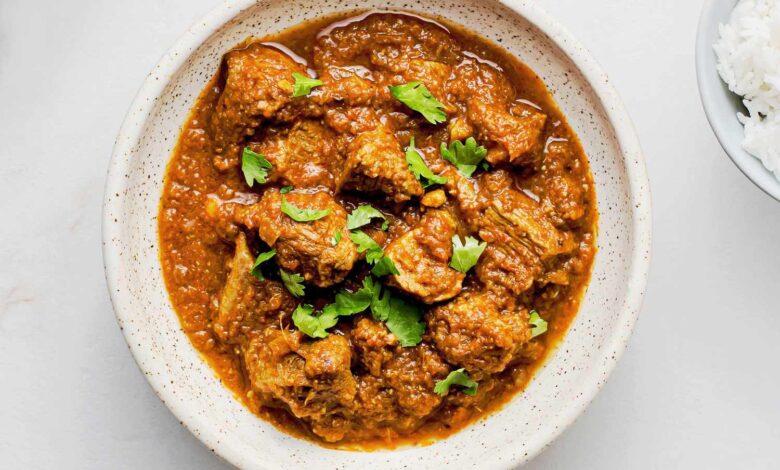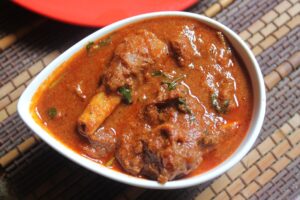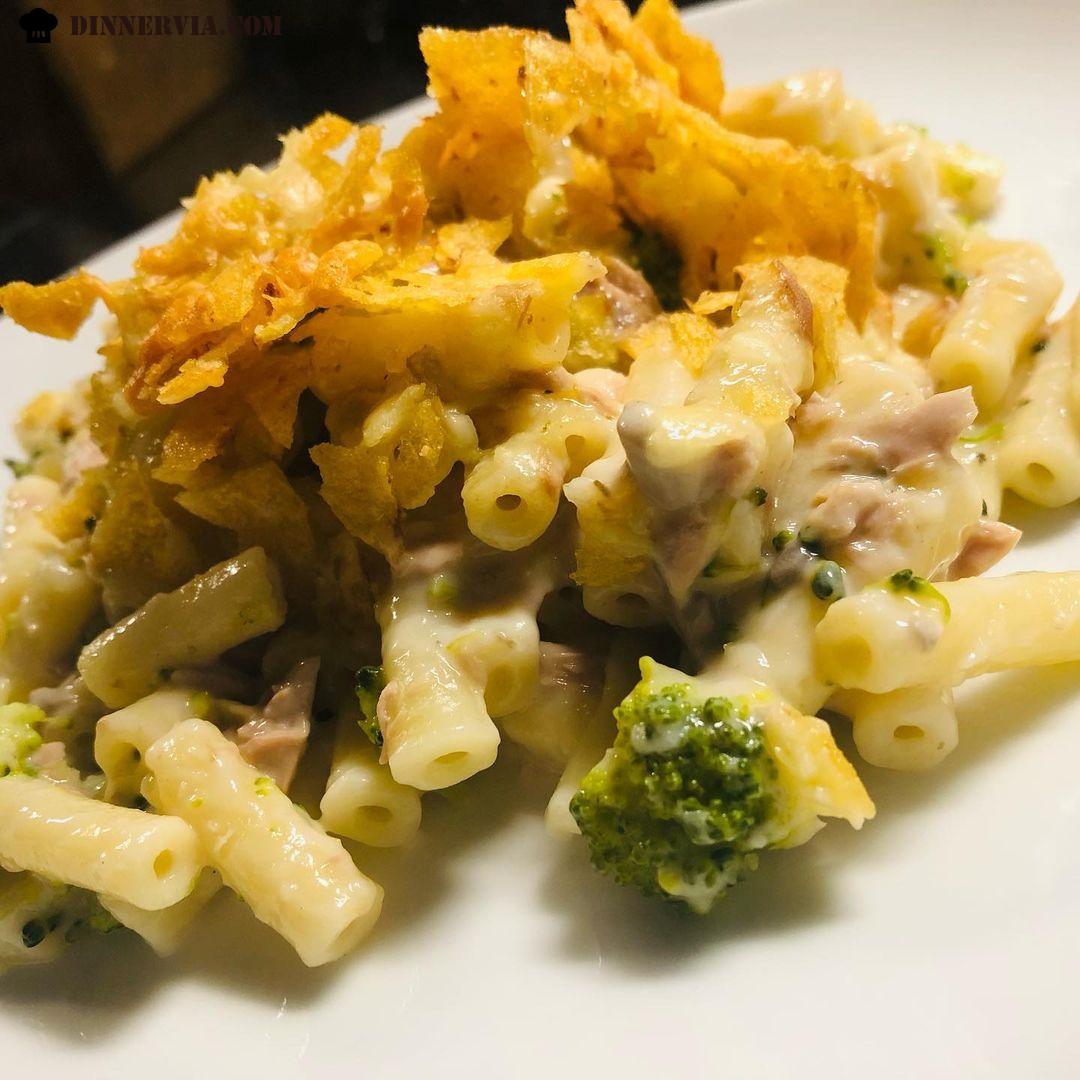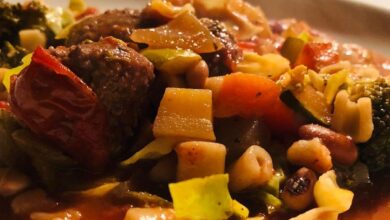Mutton Curry Recipe
Mutton Curry Recipe

Mutton Curry Recipe Introduction:
Mutton curry is a beloved dish in many parts of the world, renowned for its rich flavors and hearty nature. Originating from South Asia, particularly in countries like India, Pakistan, and Bangladesh, this dish is a staple at family gatherings, special occasions, and festive meals.
The essence of a good mutton curry lies in its deeply aromatic and flavorful gravy. The meat is slow-cooked until tender, absorbing the spices and flavors of the dish. Key ingredients typically include mutton (goat or lamb meat), onions, garlic, ginger, tomatoes, and a blend of spices like turmeric, cumin, coriander, and garam masala. The combination of these ingredients creates a curry that is both spicy and savory, with a rich, velvety texture.
Mutton curry is versatile and can be prepared in various regional styles. For instance, in North India, it might be cooked with a tomato-based sauce and aromatic spices, while in South India, it might include coconut and curry leaves for a different flavor profile. Whether served with rice, naan, or paratha, mutton curry is sure to be a flavorful and satisfying meal that brings warmth and comfort to the table.

Mutton Curry Recipe Overview:
Mutton Curry is a flavorful and aromatic dish made by slow-cooking tender pieces of mutton (goat or lamb) in a rich, spiced gravy. This dish is popular in many regions, each adding its unique twist to the recipe. The essence of mutton curry lies in its blend of spices and the slow-cooking process, which melds the flavors together and ensures that the meat is tender and infused with the curry’s spices.
Mutton Curry Recipe Ingredients:
For the Curry:
- Mutton: 500 grams (goat or lamb), cut into bite-sized pieces
- Onions: 2 large, finely chopped
- Tomatoes: 2 large, finely chopped or pureed
- Garlic: 4-5 cloves, minced
- Ginger: 1-inch piece, minced
- Yogurt: 1/2 cup (optional, for added richness and tenderness)
- Cooking Oil: 3-4 tablespoons (vegetable oil, ghee, or any preferred cooking oil)
- Fresh Cilantro: For garnish, chopped
Spices:
- Turmeric Powder: 1 teaspoon
- Coriander Powder: 2 teaspoons
- Cumin Powder: 1 teaspoon
- Red Chili Powder: 1 teaspoon (adjust according to your spice preference)
- Garam Masala: 1 teaspoon
- Whole Spices:
- Cloves: 2-3
- Green Cardamom Pods: 2-3
- Cinnamon Stick: 1-inch piece
Additional Ingredients:
- Salt: To taste
- Water: Enough to cover the meat and adjust the consistency of the curry
These ingredients combine to create a rich, flavorful mutton curry with a depth of spices and tender meat. Adjust the spices according to your taste preference to achieve the perfect balance for your curry.
Mutton Curry Recipe Ingredient Tips:
Mutton:
- Quality: Use fresh mutton with a good balance of meat and fat for tenderness and flavor. Older mutton can be tougher and may require longer cooking.
- Cut: Opt for cuts like shoulder, leg, or neck. These cuts have more connective tissue and fat, which enrich the curry.
Onions:
- Caramelization: Cook the onions until they are deeply golden brown, not just translucent. This caramelization adds sweetness and depth to the curry.
- Consistency: Finely chop or grind the onions for a smoother curry base.
Tomatoes:
- Type: Use ripe, juicy tomatoes for better flavor. Alternatively, canned tomatoes or tomato puree can be used if fresh tomatoes aren’t available.
- Cooking: Cook tomatoes thoroughly until the oil separates from the mixture. This step helps reduce the raw tomato taste and enhances the curry’s richness.
Garlic and Ginger:
- Freshness: Use fresh garlic and ginger for the best flavor. Pre-ground or jarred versions can lack the intensity needed for a rich curry.
- Preparation: Mince or paste garlic and ginger for a better distribution of flavor throughout the curry.
Yogurt:
- Consistency: Ensure the yogurt is well-beaten before adding to avoid curdling. Full-fat yogurt works best for a rich and creamy texture.
- Incorporation: Add yogurt gradually and stir well to integrate it into the curry smoothly.
Spices:
- Freshness: Use fresh ground spices whenever possible. Ground spices can lose potency over time, so buying in small quantities or grinding your own can enhance flavor.
- Whole Spices: Toasting whole spices before adding them to the curry can release essential oils and intensify their flavors.
- Balance: Adjust spice quantities according to your heat preference and taste. Adding spices incrementally allows better control over the final flavor.
Cooking Oil:
- Type: Use oils with high smoke points like vegetable oil, canola oil, or ghee. Ghee adds a traditional flavor but can be substituted based on preference.
- Amount: Adequate oil is needed for frying onions and spices to achieve a well-developed base for the curry.
Water:
- Quantity: Add enough water to cover the meat and achieve the desired consistency. You can always add more water if needed as the curry cooks.
- Cooking Time: Simmer the curry gently to allow the flavors to meld and the meat to become tender. Overcooking or high heat can toughen the meat.
Garam Masala:
- Timing: Add garam masala towards the end of cooking to preserve its aromatic qualities. Adding it too early can diminish its flavor.
- Homemade: Consider making your own garam masala blend for a personalized touch and better freshness.
Fresh Cilantro:
- Garnish: Use fresh cilantro to garnish the curry just before serving. It adds a burst of freshness and color.
Mutton Curry Recipe Equipment Needed:
- Large Pot or Pressure Cooker:
-
- Pressure Cooker: Ideal for cooking mutton quickly and tenderizing it effectively. It helps to cut down cooking time significantly.
- Large Pot: If you prefer a slow-cooking method, a heavy-bottomed pot or Dutch oven works well for simmering the curry and developing rich flavors.
- Chopping Board:
-
- Use a sturdy chopping board for cutting the mutton, onions, tomatoes, garlic, and ginger.
- Sharp Knives:
-
- Chef’s Knife: For chopping meat and vegetables.
- Paring Knife: For more detailed tasks, such as peeling or slicing.
- Measuring Cups and Spoons:
-
- To measure out spices, yogurt, and other ingredients accurately.
- Mixing Bowls:
-
- For mixing and marinating the mutton with spices and yogurt, if applicable.
- Spoon or Spatula:
-
- For stirring the curry and ensuring even cooking.
- Grinder or Food Processor:
-
- Spice Grinder: If you’re using whole spices, a grinder can help you make fresh spice powders.
- Food Processor: Useful for grinding or pureeing onions, tomatoes, garlic, and ginger into a smooth paste.
- Strainer or Sieve:
-
- For straining any excess liquid or impurities if needed.
- Ladle:
-
- For serving the curry and ladling out portions.
- Lid:
-
- Pot Lid: If using a pot, a lid helps to retain moisture and flavors while cooking. It’s also essential for simmering the curry.
- Cooking Thermometer (Optional):
-
- Useful for checking the doneness of meat, although not always necessary for curry.
- Serving Dishes:
-
- For serving the finished curry along with rice, naan, or other accompaniments.
Additional Tips:
- Wooden Spoon: Ideal for stirring, as it won’t scratch non-stick surfaces.
- Timer: To keep track of cooking times, especially when using a pressure cooker or simmering the curry.
Having these tools on hand will help streamline the cooking process and ensure that your mutton curry turns out flavorful and well-prepared
Mutton Curry Recipe Step-by-Step Instructions:
- Preparation:
-
- Wash and pat dry the mutton pieces. Set aside.
- Finely chop the onions and tomatoes. Mince the garlic and ginger.
- Cooking the Base:
- Heat Oil: In a large pot or pressure cooker, heat 3-4 tablespoons of oil over medium heat.
- Add Whole Spices: Add cloves, cardamom pods, and cinnamon stick. Sauté for about 30 seconds until they release their aroma.
- Cook Onions: Add finely chopped onions to the pot. Cook, stirring frequently, until the onions turn golden brown. This can take 8-10 minutes.
- Add Garlic and Ginger: Stir in minced garlic and ginger. Sauté for an additional 2 minutes until fragrant.
- Building the Curry Base:
- Add Tomatoes: Add the chopped or pureed tomatoes to the pot. Cook until the tomato mixture thickens and the oil starts to separate, about 5-7 minutes.
- Incorporate Spices: Mix in turmeric powder, coriander powder, cumin powder, and red chili powder. Cook for another 2 minutes, stirring continuously to blend the spices with the tomato-onion mixture.
- Adding the Mutton:
- Brown the Mutton: Add the mutton pieces to the pot. Stir well to coat the meat with the spice mixture. Cook for about 5-7 minutes until the mutton is browned on all sides.
- Add Yogurt (Optional): If using yogurt, whisk it well and add it to the pot. Mix thoroughly and cook for another 2 minutes. This helps tenderize the meat and adds richness to the curry.
- Simmering:
- Add Water: Pour in enough water to cover the meat. Stir well to combine.
- Pressure Cook: If using a pressure cooker, cover and cook for about 15-20 minutes on medium heat until the mutton is tender. Release the pressure naturally.
- Simmer: If using a pot, cover and simmer on low heat for 1.5 to 2 hours, stirring occasionally, until the mutton is tender and the gravy thickens. Add more water if necessary.
- Finishing Touches:
- Add Garam Masala: Stir in garam masala and adjust salt to taste. Cook for another 5 minutes to allow the flavors to meld.
- Garnish: Garnish with chopped fresh cilantro.
- Serving:
- Serve the mutton curry hot with steamed rice, naan, or paratha. Enjoy it with a side of yogurt or raita if desired.
This mutton curry recipe delivers a rich, flavorful dish that’s perfect for special occasions or a hearty family meal. Enjoy!
Tips and Tricks:
Choosing and Preparing Mutton:
- Quality of Meat: Opt for fresh mutton from a reputable butcher. Cuts like shoulder, leg, or neck are ideal for curries due to their flavor and tenderness.
- Marination: For extra tenderness and flavor, marinate the mutton with yogurt, turmeric, and a bit of salt for a few hours or overnight. This helps to tenderize the meat and enhance the flavors.
Cooking Tips:
- Searing the Meat: Brown the mutton pieces well before adding the spices. This caramelization adds depth and richness to the curry.
- Onion Cooking: Cook the onions until they are deeply golden brown. This step is crucial for a rich and flavorful curry base.
- Spice Blending: Toast whole spices (like cloves, cardamom, and cinnamon) in the hot oil before adding them to the pot. This helps release their essential oils and enhances the curry’s aroma.
- Layering Flavors: Add spices at different stages of cooking to build layers of flavor. For example, some spices can be added early with the onions, while others like garam masala are added at the end to preserve their aroma.
Consistency and Texture:
- Adjusting Consistency: If the curry is too thick, add warm water or stock to reach your desired consistency. If it’s too thin, simmer uncovered to reduce and thicken the gravy.
- Simmering Time: For tender mutton, slow cooking is key. If using a pressure cooker, ensure not to overcook, as it can make the meat tough. If cooking in a pot, allow enough time for the meat to become tender and the flavors to meld.
Flavor Enhancement:
- Adding Yogurt: If using yogurt, whisk it before adding to prevent curdling. Yogurt adds a nice tangy flavor and richness to the curry.
- Garam Masala: Add garam masala at the end of cooking to maintain its aromatic properties. Too much garam masala can overpower the dish, so use it sparingly.
Serving Suggestions:
- Resting Time: Let the curry rest for a few minutes after cooking. This allows the flavors to settle and intensify.
- Garnishing: Fresh cilantro or mint can brighten up the dish and add a fresh contrast to the rich flavors of the curry.
- Accompaniments: Mutton curry pairs well with rice, naan, or paratha. For a balanced meal, consider serving it with a side of raita or a simple salad.
Storage Tips:
- Refrigeration: Store leftover mutton curry in an airtight container in the refrigerator for up to 3-4 days.
- Freezing: Mutton curry can be frozen for up to 3 months. Let it cool completely before transferring to a freezer-safe container. Thaw in the refrigerator overnight and reheat thoroughly before serving.
Serving Suggestions:
1. Rice Dishes:
- Steamed Basmati Rice: The aromatic and fluffy texture of basmati rice makes it a perfect base for soaking up the rich gravy of the mutton curry.
- Jeera Rice: Flavored with cumin seeds, this simple rice dish adds a subtle, fragrant touch that complements the spiced curry.
- Pulao: A mildly spiced rice dish with vegetables or nuts that pairs well with mutton curry for a more elaborate meal.
2. Indian Breads:
- Naan: Soft and pillowy naan, whether plain or buttered, is excellent for scooping up the curry and enjoying the rich sauce.
- Roti/Chapati: Whole wheat flatbreads that are perfect for dipping into the curry and balancing the flavors.
- Paratha: Flaky and crispy parathas, which can be plain or stuffed, add a delightful texture contrast to the curry.
3. Accompaniments:
- Raita: A cooling yogurt-based side dish with vegetables or herbs that helps balance the spiciness of the curry. Options include cucumber raita, boondi raita, or mint raita.
- Salad: A fresh salad with ingredients like cucumber, tomato, onion, and lemon juice provides a refreshing contrast. Add some chopped herbs for extra flavor.
- Pickles: Indian pickles (achaar) such as mango or lime pickle add a tangy and spicy element that complements the richness of the curry.
4. Vegetables and Sides:
- Vegetable Kachumber: A simple salad made with diced vegetables, lemon juice, and spices. It adds a crisp and tangy element to the meal.
- Sautéed Greens: Spinach, kale, or other leafy greens sautéed with garlic and spices can be a nutritious and flavorful side.
- Aloo Gobi: A spiced potato and cauliflower dish that complements the curry without overwhelming it.
5. Indian Desserts:
- Gulab Jamun: Sweet, syrup-soaked dough balls that offer a rich and indulgent end to the meal.
- Rasgulla: Soft, spongy cheese balls soaked in a light sugar syrup, providing a refreshing and sweet contrast.
- Kheer: A creamy rice pudding flavored with cardamom and garnished with nuts, offering a sweet and cooling end to the meal.
6. Beverages:
- Mango Lassi: A sweet and tangy yogurt drink that balances the spiciness of the curry and provides a refreshing complement.
- Buttermilk: A lightly spiced, cooling drink that aids digestion and offers a refreshing taste.
- Chai: A spiced tea, which can be enjoyed as a light beverage to end the meal on a comforting note.
Presentation Tips:
- Garnishing: Top the mutton curry with fresh cilantro or mint before serving to add color and freshness.
- Serving Platters: Use warm serving dishes and platters to keep the curry and accompaniments at an optimal temperature.
- Side Dishes: Arrange rice, bread, and sides in separate bowls or on the plate for a well-organized and appealing presentation.
These serving suggestions will help you create a well-rounded and satisfying meal with your mutton curry, ensuring a delightful dining experience for you and your guests.
FAQs:
- How can I make mutton curry less spicy?
Answer: To reduce the spiciness of your mutton curry:
- Use Less Chili Powder: Reduce the amount of red chili powder or omit it entirely.
- Add Dairy: Incorporate more yogurt or cream to balance the heat.
- Add Sweetness: A small amount of sugar or honey can counteract the spice.
- Increase Liquid: Add more water or broth to dilute the spice level.
- How do I ensure the mutton is tender?
Answer: To make sure the mutton is tender:
- Marinate: Marinate the mutton in yogurt and spices to help tenderize it.
- Cook Slowly: Simmer the curry slowly to allow the meat to become tender. Use a pressure cooker for faster results but be cautious not to overcook.
- Check Cuts: Choose cuts like shoulder or leg, which are better suited for slow cooking and become tender more easily.
- Can I use boneless meat for mutton curry?
Answer: Yes, you can use boneless mutton. Boneless meat cooks faster and is easier to eat, but it may lack the richness of flavor that bones contribute. Adjust the cooking time accordingly, as boneless mutton will cook more quickly than bone-in pieces.
- How do I thicken the curry if it’s too watery?
Answer: To thicken a watery curry:
- Simmer Longer: Cook the curry uncovered to reduce excess liquid and thicken the gravy.
- Use a Thickening Agent: Add a paste made from ground nuts (like cashews or almonds) or a mixture of cornstarch and water.
- Add Mashed Vegetables: Blend a portion of the cooked vegetables and add them back into the curry.
- Can I make mutton curry ahead of time?
Answer: Yes, mutton curry can be made ahead of time:
- Refrigerate: Store the curry in an airtight container in the refrigerator for up to 3-4 days.
- Freeze: For longer storage, freeze the curry in a freezer-safe container for up to 3 months. Thaw in the refrigerator overnight before reheating.
- Reheat Carefully: Reheat the curry thoroughly on the stove or in the microwave, stirring occasionally to ensure even heating.




